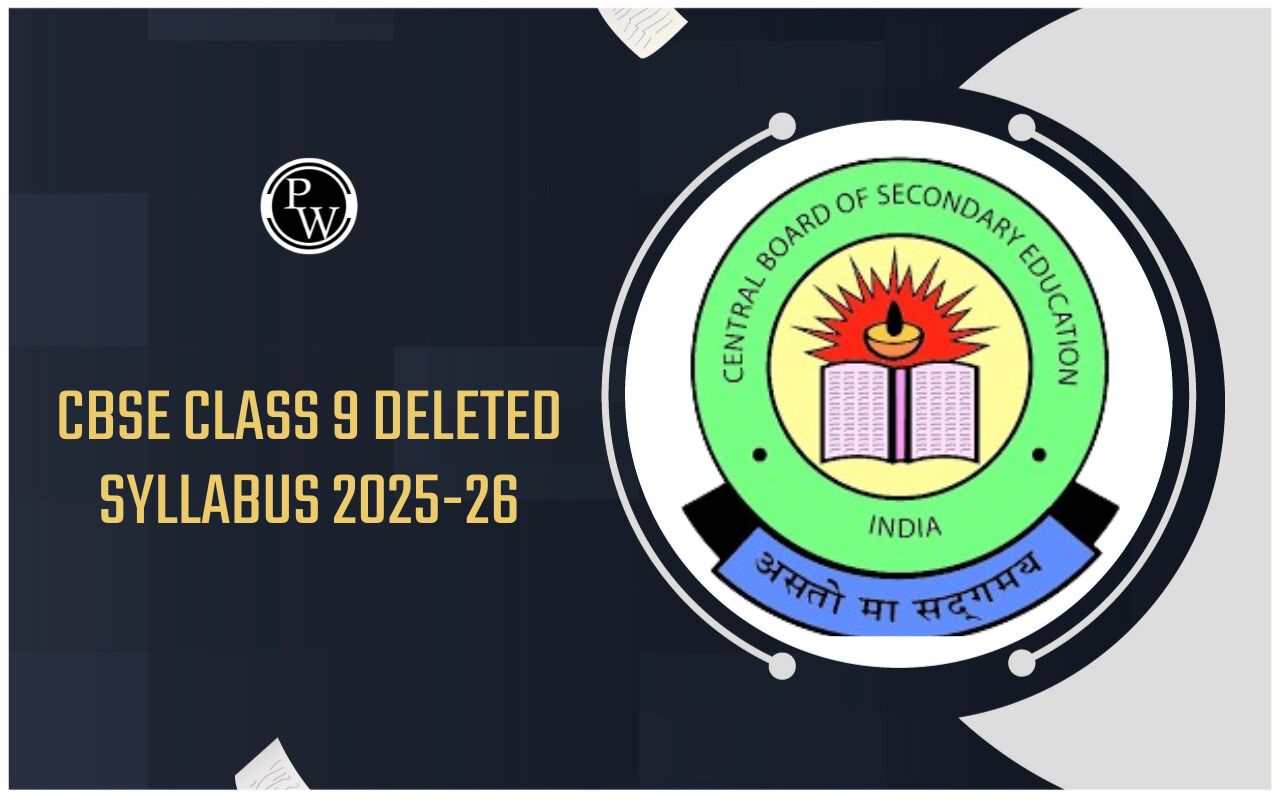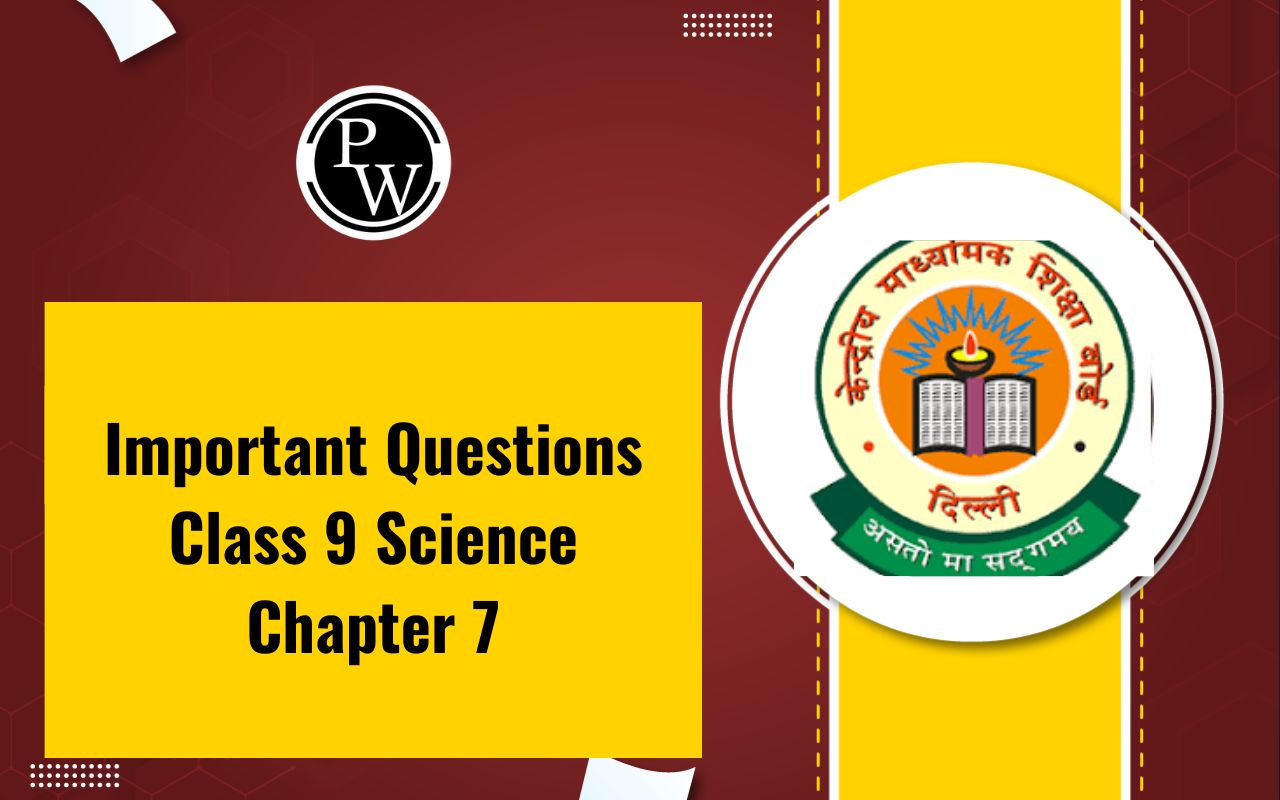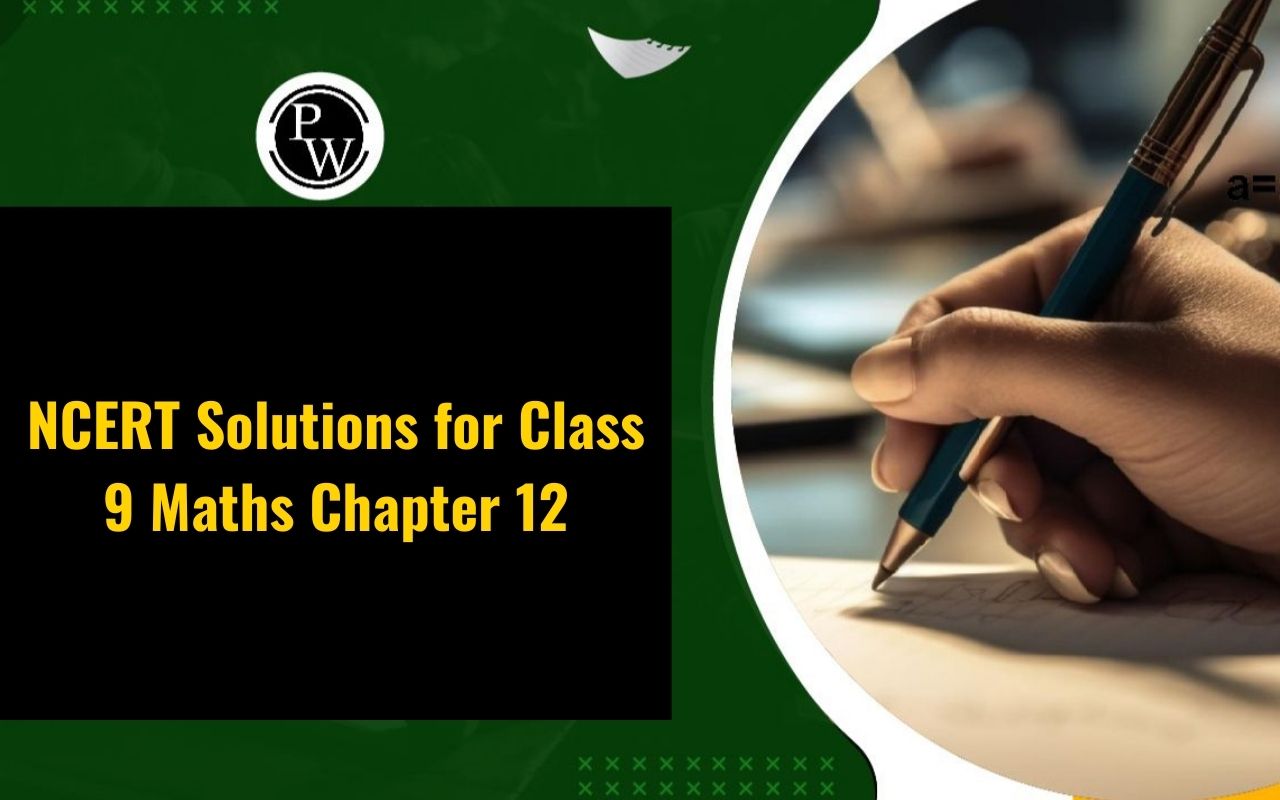
RS Aggarwal Solutions Class 9 Maths Chapter 1: RS Aggarwal Class 9 Chapter 1 can have practical applications in real life. A prime example demonstrating the usefulness of learning real numbers arises when solving everyday mathematical problems. For instance, consider a scenario where there are 10 students but only four benches available, with each bench accommodating 2 students side by side. By applying real numbers, one can determine the number of students left without a seat in the classroom.
Moreover, while working through the exercises provided in RS Aggarwal, students will observe how rational numbers, integers, and natural numbers can be effectively represented on the number line. RS Aggarwal Class 9 Solutions Chapter 1 not only provides answers to the questions found at the end of the chapter but also offers deeper insights into the concepts covered. These solutions, available in PDF format, have been created by experienced mathematics teachers with over 8 years of teaching experience.RS Aggarwal Solutions Class 9 Maths Chapter 1 - Number Systems PDF
You can find the solutions for RS Aggarwal Class 9 Maths Chapter 1 - Number Systems in the PDF linked below. This PDF has answers to all the questions in the chapter, helping you understand the topics better. Whether you're studying for exams or just want to clarify your doubts, this resource can be really helpful.RS Aggarwal Solutions Class 9 Maths Chapter 1 - Number Systems PDF
RS Aggarwal Solutions Class 9 Maths Chapter 1 - Number Systems
The solutions for RS Aggarwal Class 9 Maths Chapter 1 - Number Systems are available below. These solutions provide step-by-step explanations for each question in the chapter, making it easier for students to understand and solve problems related to number systems.RS Aggarwal Solutions Class 9 Chapter 1 – Real Numbers Exercise 1.1
Question 1.
Solution:
A number in the form of p/q where p and q are integers and q ≠ 0, is called a rational number (1) 4/5 (2) 1/5 (3) 5/4 (4) 4/1 = 4 (5) 5/2 (6) 1/7 (7) 0/1 = 0 (8) 9/5 (9) 5/5 = 1 (10) 4/9 are all rational numbers.Question 2.
Solution:
The given rational number are represented on a number line on given below :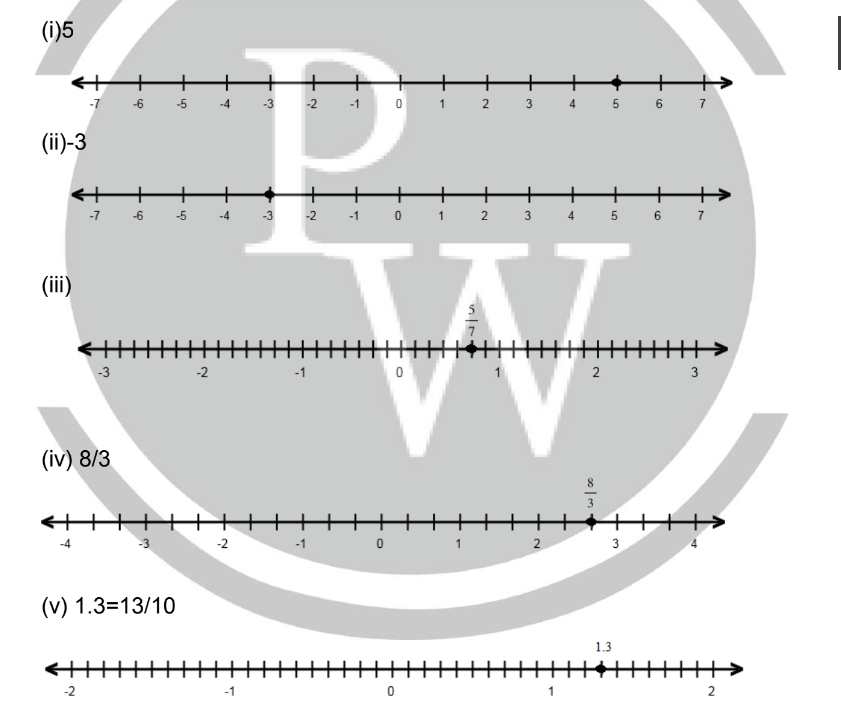
Question 3.
Solution:
We know that, if a and b are two rational numbers, then a rational number between a and b will be
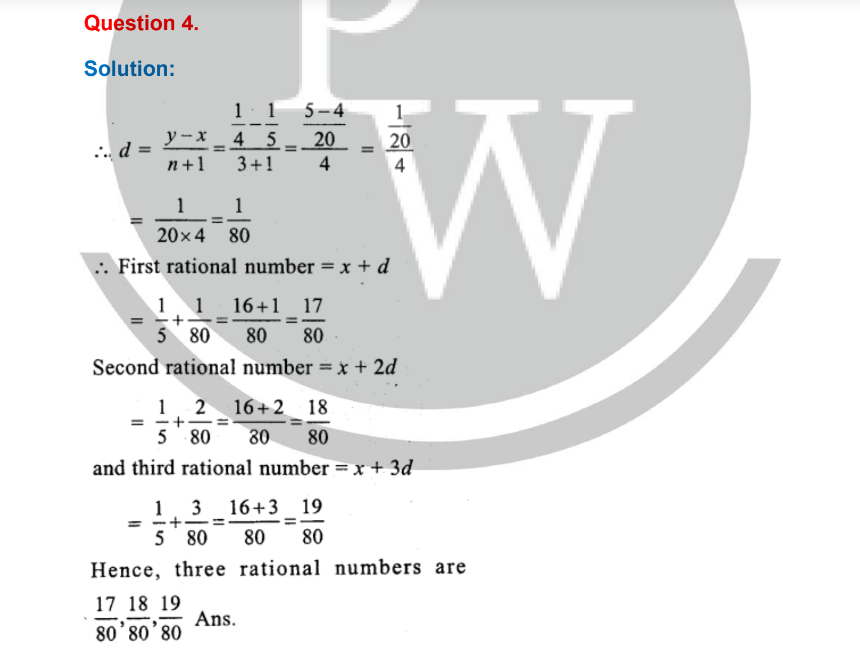
Question 5.
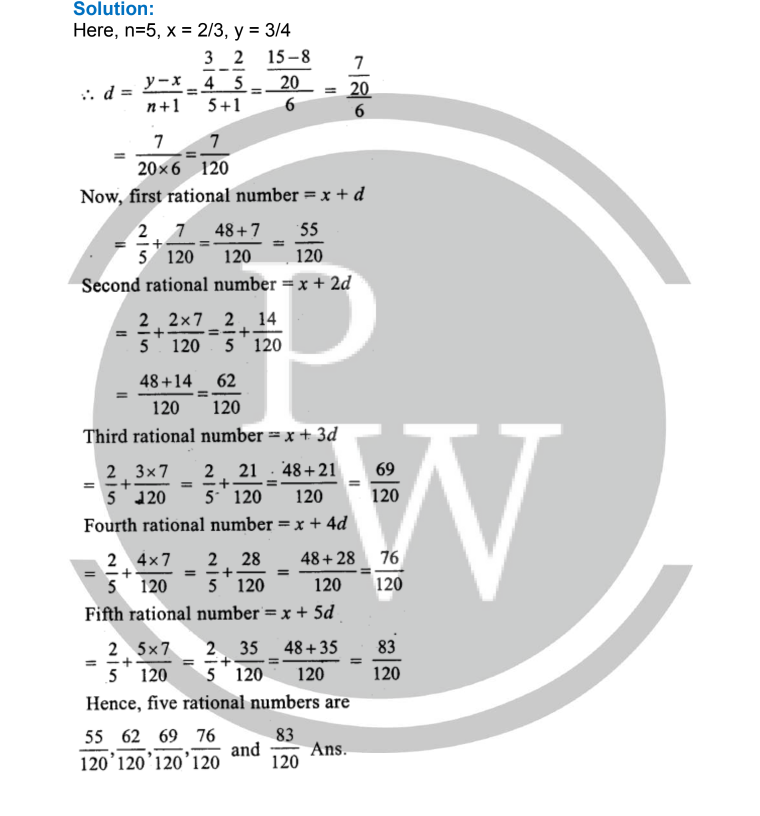
Question 6.
Solution:
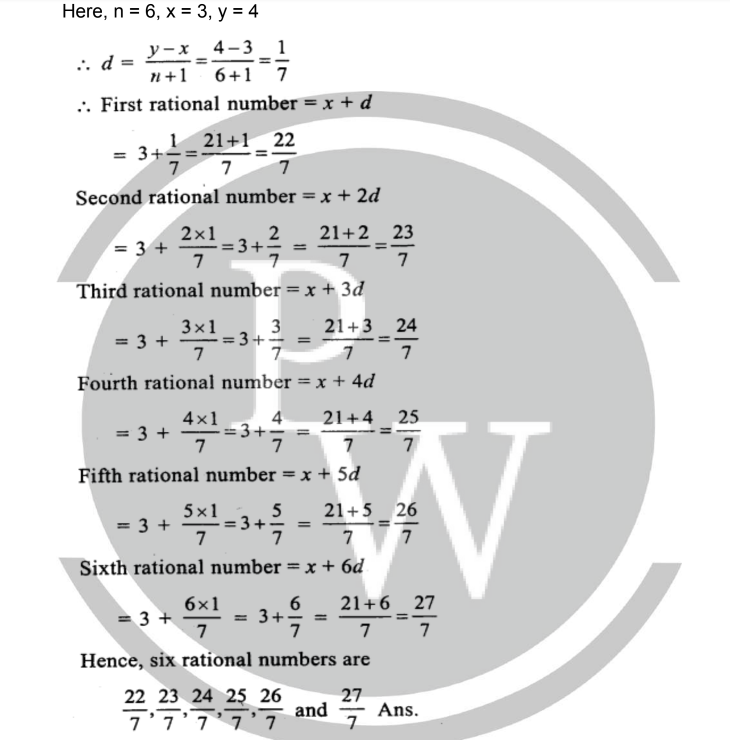
Question 7.
Solution:
Here, n=16, x=2.1, y=2.2 We know: d = y−x / n+1=2.2−2.1 / 16+1 =0.1/17=1/170= 0.005 (approx.) So, 16 rational numbers between 2.1 and 2.2 are: (x + d), (x + 2d), ...(x + 16d) = [2.1 + 0.005], [2.1 + 2(0.005)],...[2.1 + 16(0.005)] = 2.105, 2.11, 2.115, 2.12, 2.125, 2.13, 2.135, 2.14, 2.145, 2.15, 2.155, 2.16, 2.165, 2.17, 2.175 and 2.18RS Aggarwal Solutions Class 9 Chapter 1 – Real Numbers Exercise 1.2
Question 1.
Solution:
(i) Denominator of 13/80 is 80. And, 80 = 24×5 Therefore, 80 has no other factors than 2 and 5. Thus, 13/80 is a terminating decimal. (ii) Denominator of 7/24 is 24. And, 24 = 23×3 So, 24 has a prime factor 3, which is other than 2 and 5. Thus, 7/24 is not a terminating decimal. (iii) Denominator of 5/12 is 12. And, 12 = 22×3 So, 12 has a prime factor 3, which is other than 2 and 5. Thus, 5/12 is not a terminating decimal. (iv) Denominator of 8/35 is 35. And, 35 = 7×5 So, 35 has a prime factor 7, which is other than 2 and 5. Thus, 8/35 is not a terminating decimal. (v) Denominator of 16/125 is 125. And, 125 = 53 Therefore, 125 has no other factors than 2 and 5. Thus, 16/125 is a terminating decimal.Question 2.
Solution:
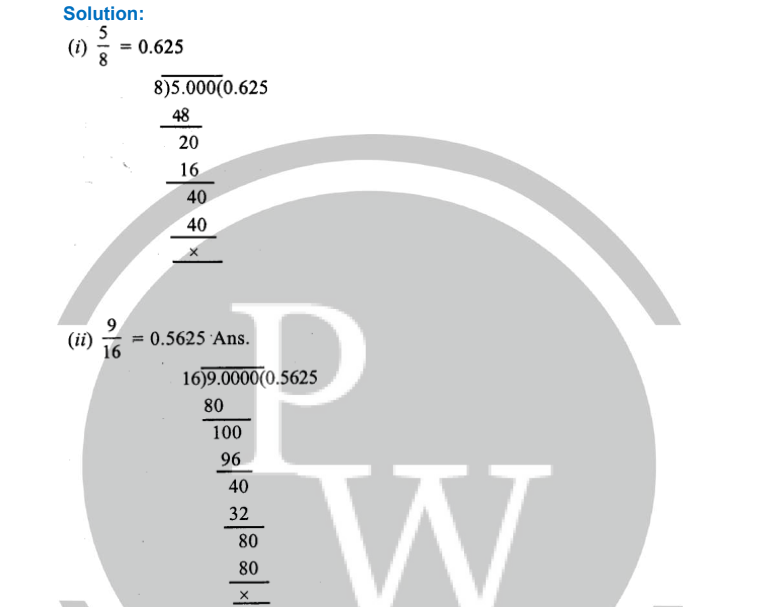
Question 3.
Solution:
(i) True Natural numbers start from 1 to infinity and whole numbers start from 0 to infinity; hence, every natural number is a whole number. (ii) False 0 is a whole number but not a natural number, so every whole number is not a natural number. (iii) True Every integer can be expressed in the p/q form. (iv) False Because whole numbers consist only of numbers of the form p/1, where p is a positive number. On the other hand, rational numbers are the numbers whose denominator can be anything except 0. (v) True Every terminating decimal can be easily expressed in the p/q form. (vi) True Every terminating decimal can be easily expressed in the p/q form. (vii) True 0 can be expressed in the form p/q, so it is a rational number.RS Aggarwal Solutions Class 9 Chapter 1 – Real Numbers Exercise 1.3
Question 1.
Solution:
A number that can neither be expressed as a terminating decimal nor be expressed as a repeating decimal is called an irrational number. A rational number, on the other hand, is always a terminating decimal, and if not, it is a repeating decimal. Examples of irrational numbers: 0.101001000... 0.232332333...Question 2.
Solution:
(i) √4 = ±2, it is a rational number (ii) √196 = ±14 it is a rational number (iii) √21 It is irrational number. (iv) √43 It is irrational number. (v) 3 + √3 It is irrational number because sum of a rational and an irrational number is irrational (vi) √7 – 2 It is irrational number because difference of a rational and irrational number is irrational (vii) 2/3 √6 . It is irrational number because product of a rational and an irrational number is an irrational number. (viii) 0.6 = 0.6666.... It is rational number because it is a repeating decimal. (ix) 1.232332333.... It is irrational number because it not repeating decimal (x) 3.040040004.... It is irrational number because it is not repeating decimal. (xi) 3.2576 It is rational number because it is a terminating decimal. (xii) 2.3565656.... = 2.3 56 It is rational number because it is a repeating decimal. (xiii) π It is an irrational number (xiv) 22/7. It is a rational number which is in form of p/qQuestion 3.
Solution:
(i) 4 + √5 : It is irrational number because in it, 4 is a rational number and √5 is irrational and sum of a rational and an irrational is also an irrational. (ii) (-3 + √6) It is irrational number because in it, -3 is a rational and √6 is irrational and sum or difference of a rational and irrational is an irrational. (iii) 5√7 : It is irrational because 5 is rational and √7 is irrational and product of a rational and an irrational is an irrational. (iv) -3√8 : It is irrational because -3 is a rational and √8 is an irrational and product of a rational and an irrational is also an irrational. (v) 2/√5 : It is irrational because 2 is a rational and √5 is an irrational and quotient of a rational and an irrational is also an irrational. (vi) 4/√3: It is irrational because 4 is a rational and √3 is an irrational number and quotient of a rational and irrational is also an irrational.Question 4.
Solution:
(i) True. (ii) False, as the sum of two irrational number is irrational is not always true. (iii) True. (iv) False, as the product of two irrational numbers is irrational is not always true. (v) True. (vi) True.RS Aggarwal Solutions Class 9 Chapter 1 – Real Numbers Exercise 1.4
Question 1.
Solution:
(i) 2√3−5√2+√3+2√2 =(2√3+√3)+(2√2−5√2) =3√3−3√2 (ii) 22–√+53–√−75–√+33–√−2–√+5–√ =2√2−√2+5√3+3√3+√5−7√5 =√2+8√3−6√5 (iii) 2/3√7−1/2 √2+6√11+1/3√7+3/2√2−√11 =2/3√7+1/3√7−√11+6√11+3/2√2−1/2√2 =√7+5√11+√2Question 2.
Solution:
i) 3√5 by 2 =3×2×√5×√5 =6×5=30 (ii) 6√15 by 4√3 =6×4×√5×√3×√3 =24×3×√5 =7/2√5 (iii) 2√6 by 3√3 =2×3×√2×√3×√3 =6×3×√2=1/8√2 (iv) 3√8 by 3√2 =3×3×√2×√2×√2×√2 =9×4=36 (v) √10 by √40 =√2×√5×√2×√2×√2×√5 =√2×√2×√2×√2×√5×√5 =2×2×5=20 (vi) 3√28 by 2√7 =6√7×√4×√7 =6×7×√4 =42×2=84Question 3.
Solution:
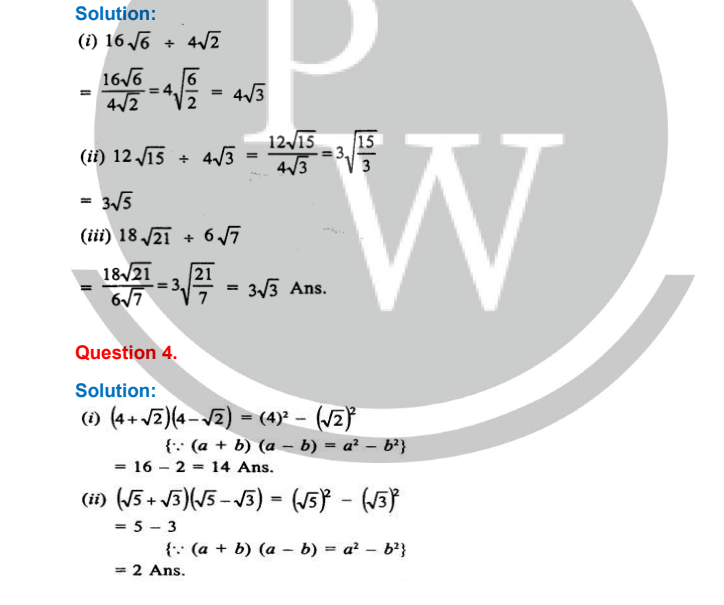
Question 5.
Solution:
(i) Draw a line segment AB = 3.2 units (cm) and extend it to C such that BC = 1 unit. (ii) Find the mid-point O of AC. (iii) With centre O and OA as radius draw a semicircle on AC (iv) Draw BD ⊥ AC meeting the semicircle at D. (v) Join BD which is √3.2 units. (vi) With centre B and radius BD, draw an arc meeting AC when produced at E. Then BE = BD = √3.2 units. Ans.Question 6.
Solution:
(i) Draw a line segment AB = 7.28 units and produce is to C such that BC = 1 unit (cm) (ii) Find the mid-point O of AC. (iii) With centre O and radius OA, draw a semicircle on AC. (iv) Draw a perpendicular BD at AC meeting the semicircle at D Then BD = √7.28 units. (v) With centre B and radius BD, draw an arc which meet AC produced at E. Then BE = BD = √7.28 units.Question 7.
Solution:
ADDITION PROPERTIES OF REAL NUMBERS
(i) Closure property: The sum of two real numbers is always a real number. (ii) Associative law: (a + b) + c = a + (b + c) for all real numbers a, b and c. (iii) Commutative law: a + b = b + a for all real numbers a and b. (iv) Existence of additive identity: 0 is called the additive identity for real numbers. As, for every real number a , 0 + a = a + 0 = a (v) Existence of additive inverse: For each real number a, there exists a real number (−a) such that a + (−a) = 0 = (−a) + a. Here, a and (−a) are the additive inverse of each other.MULTIPLICATION PROPERTIES OF REAL NUMBERS
(i) Closure property: The product of two real numbers is always a real number. (ii) Associative law: (ab)c = a(bc) for all real numbers a, b and c. (iii) Commutative law: a ×b = b ×a for all real numbers a and b. (iv) Existence of multiplicative identity: 1 is called the multiplicative identity for real numbers. As, for every real number a , 1 ×a = a × 1 = a (v) Existence of multiplicative inverse: For each real number a, there exists a real number (1/a) such that a (1/a) = 1 = (1/a)a. Here, a and (1/a) are the multiplicative inverse of each otherRS Aggarwal Solutions Class 9 Chapter 1 – Real Numbers Exercise 1.5
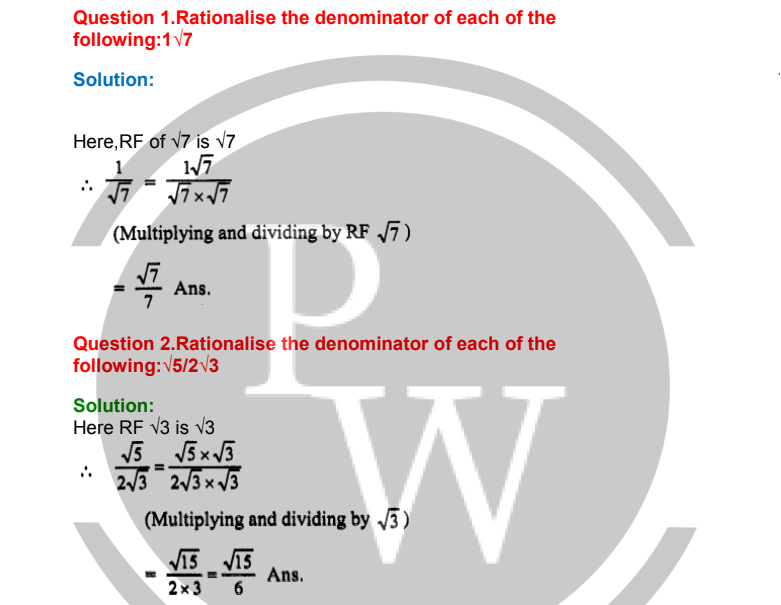
Questions 3.
Solutions:
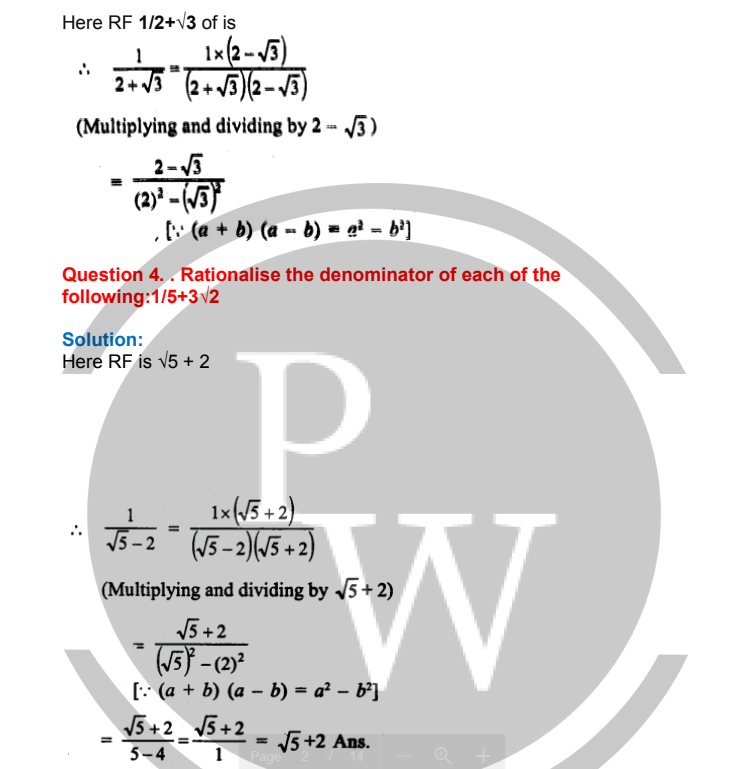
Question 5. Rationalise the denominator of each of the following:1/5+3√2
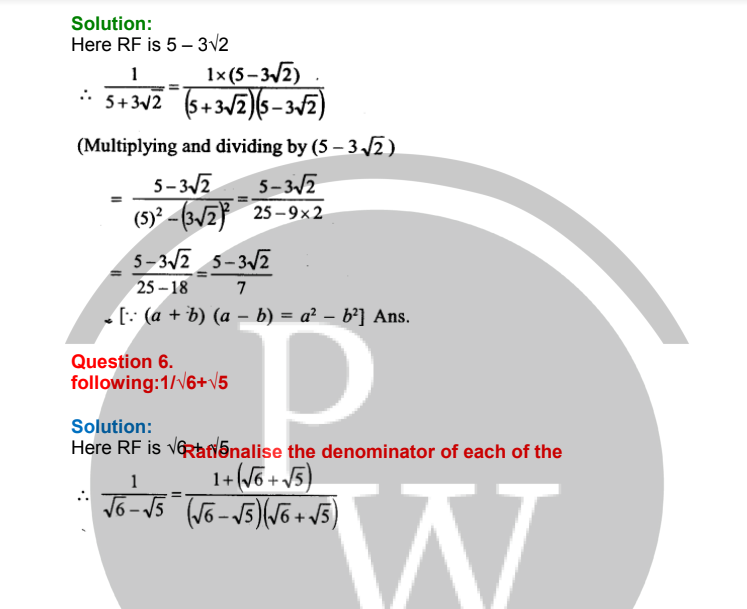
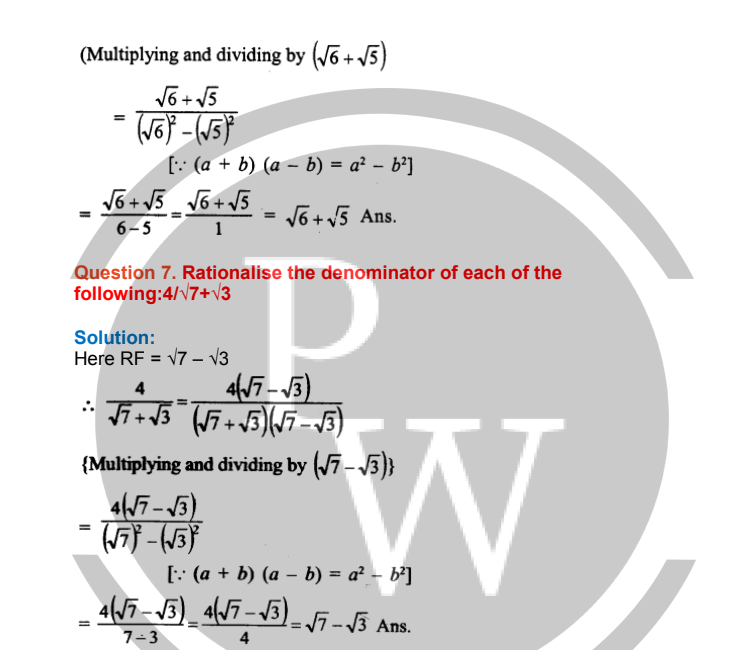
Question 8. Rationalise the denominator of each of the following: √3-1/√3+1
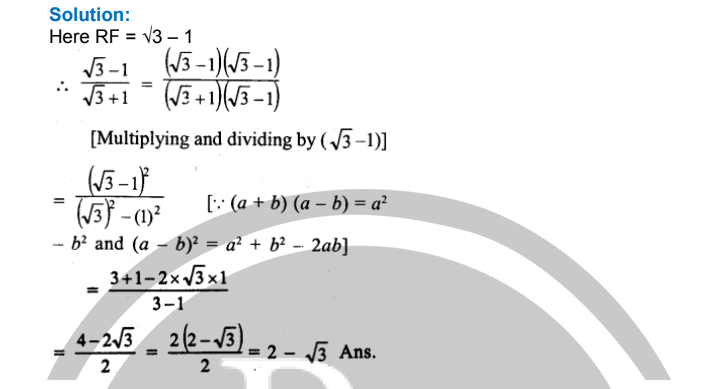
Question 9. Rationalise the denominator of each of the following: 3- 2√2/3+2√2
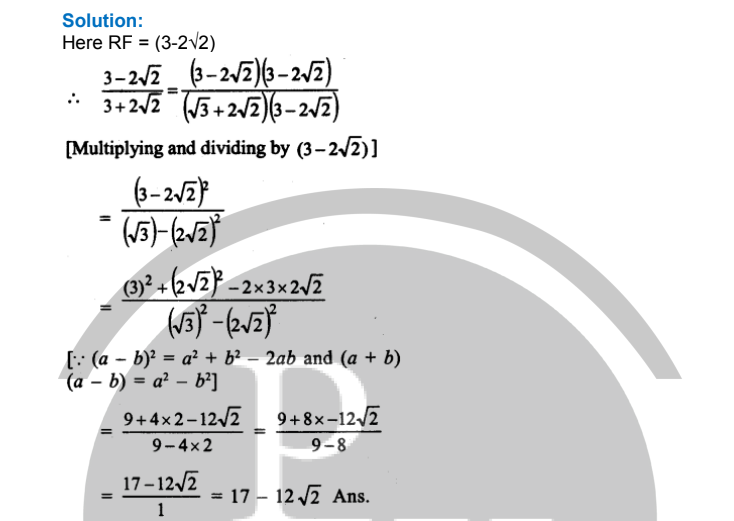
Find the values of a and b in each of the following :
Question 10. Find the values of a and b in each of the following. √3+1/√3−1=a+b√3
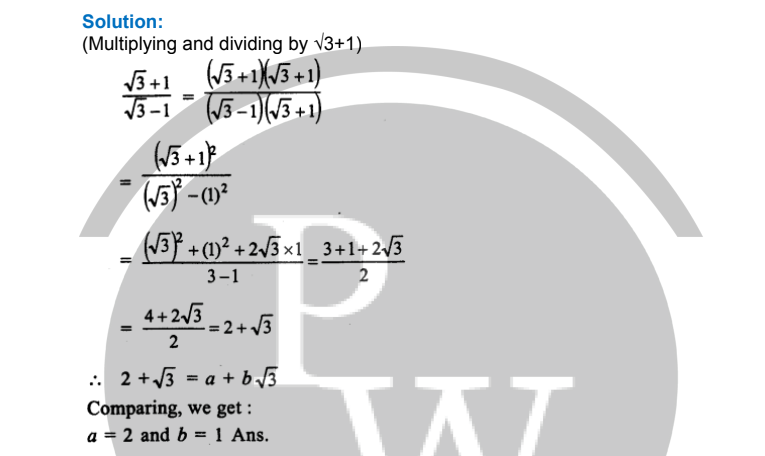
Question 11. Find the values of a and b in each of the following.
3+√2/3−√2 =a+b√2

Question 12. Find the values of a and b in each of the following.
5−√6/5+√6=a−b√6
Solution:
In , 5−√6/5+√6 RF is (5-√6)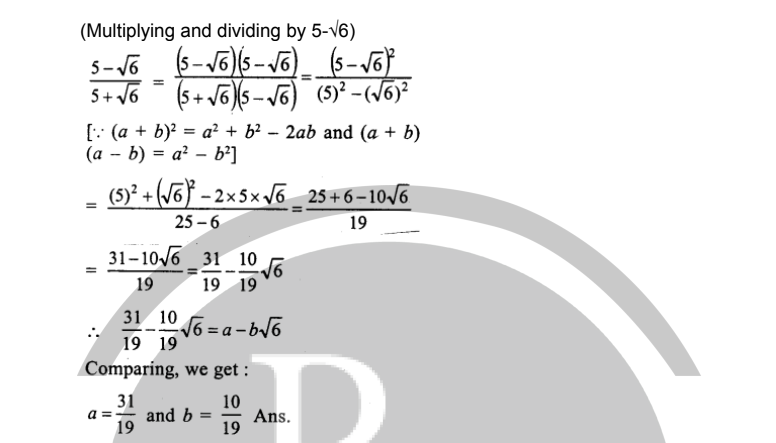
Question 13. Find the values of a and b in each of the following.
5−2√3 / 7+4√3 =a−b√3
Solution:
In 5−2√3 / 7+4√3, RF is 7-4√3 (Multiplying and dividing by 7-4√3)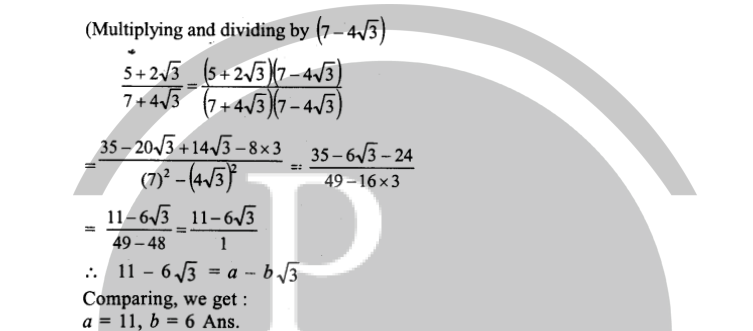
Question 14. Simplify:( √5−1 / √5+1 + √5+1 / √5−1)
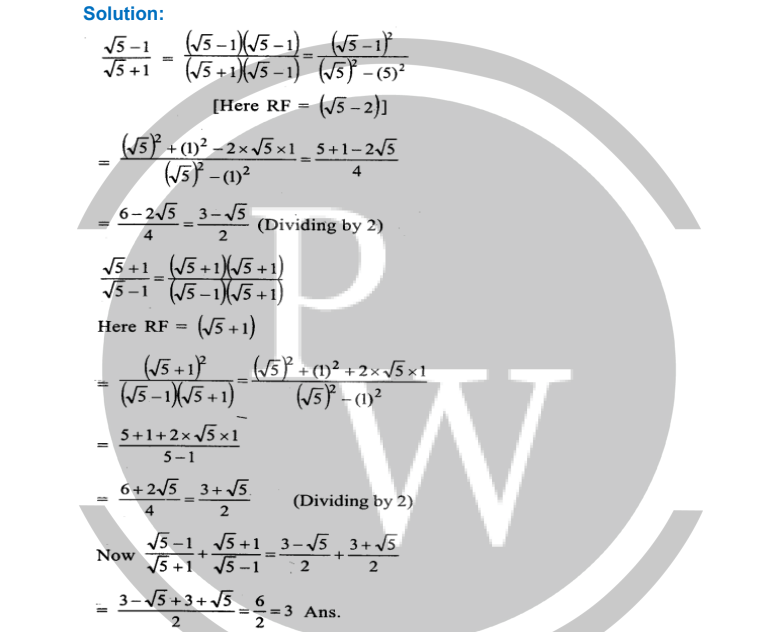
Question 15. (4+√5 / 4−√5 + 4−√5 / 4+√5).
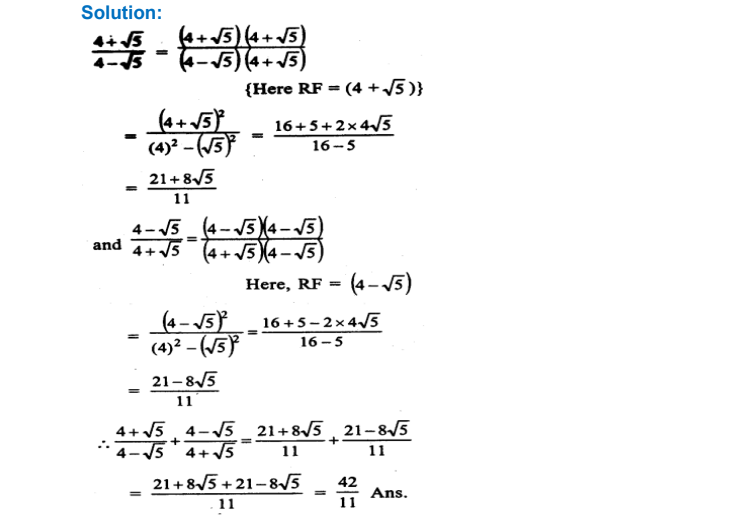
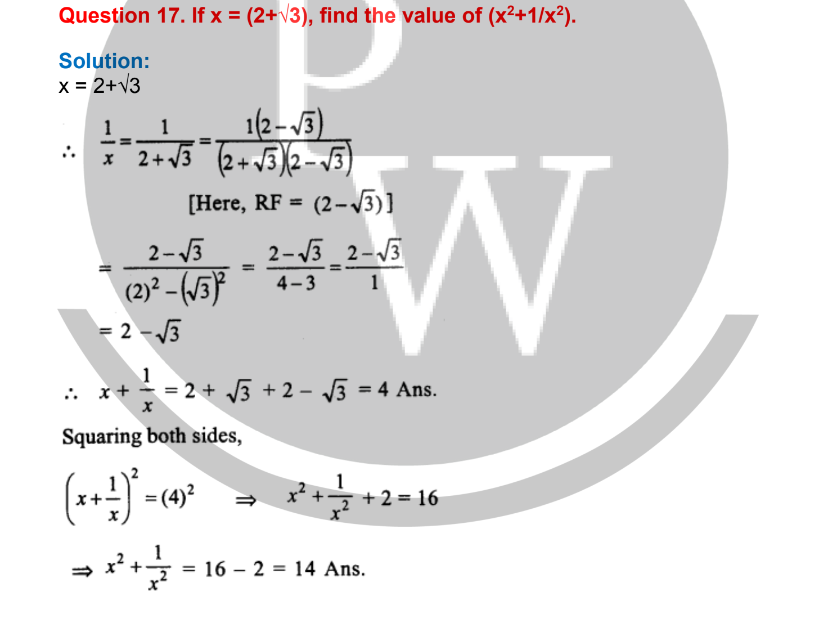
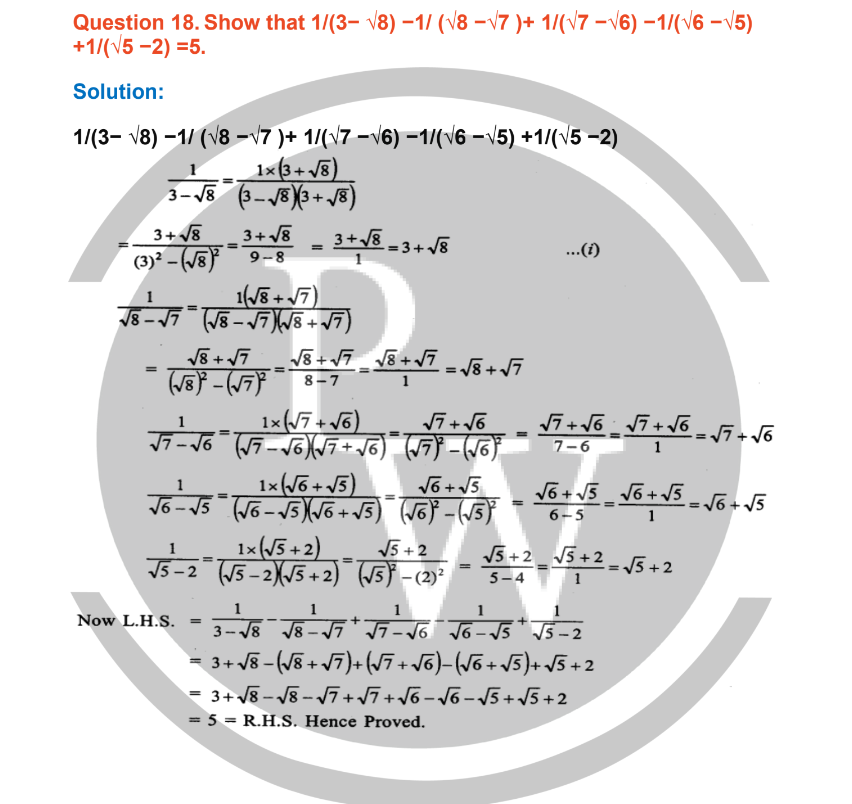
RS Aggarwal Solutions Class 9 Maths Chapter 1 FAQs
What topics are covered in Chapter 1 of RS Aggarwal Class 9 Maths?
Why is it important to study number systems?
How can I improve my understanding of number systems?


